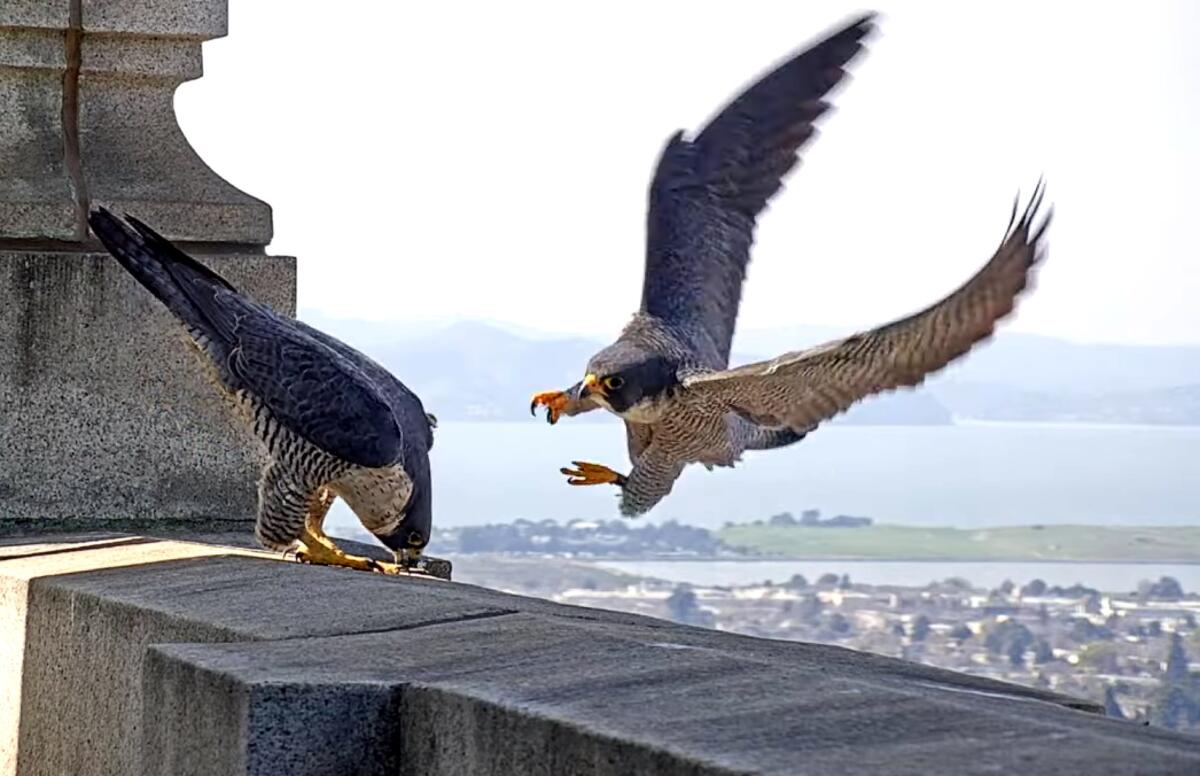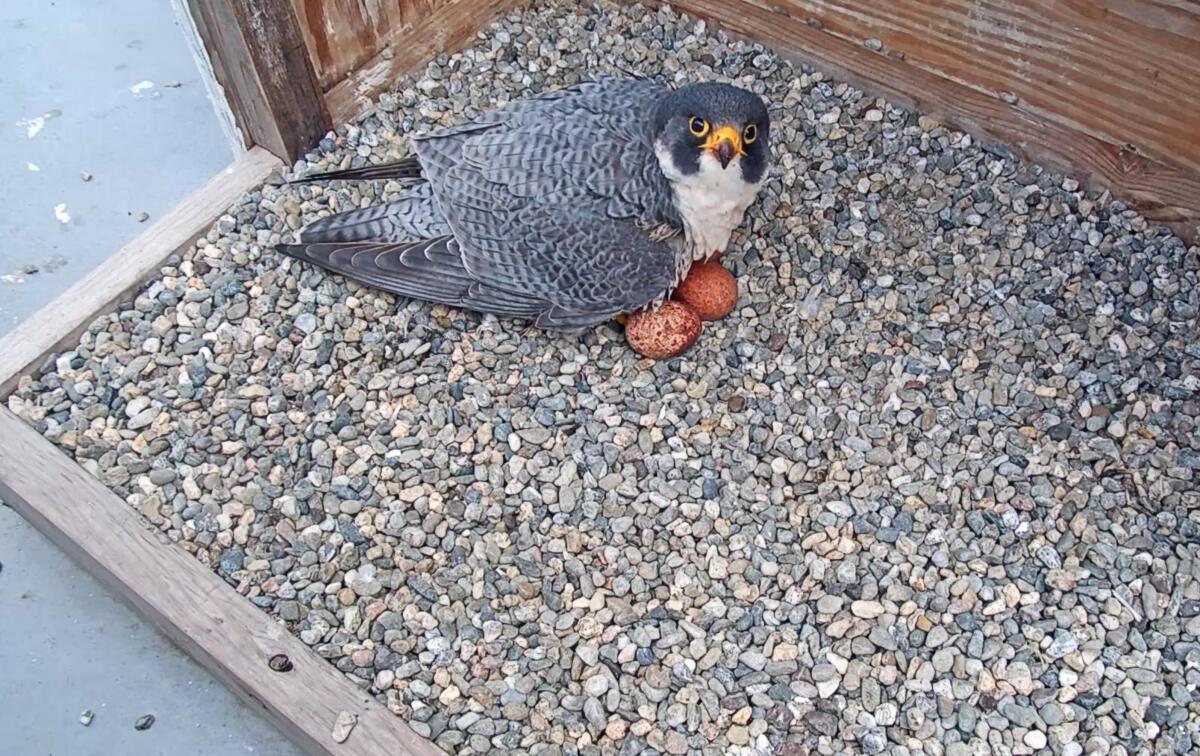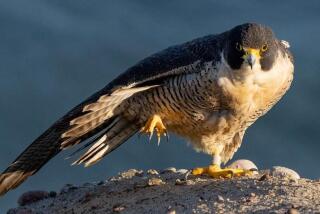The avian soap opera unfolding atop this Berkeley bell tower has humans riveted

- Share via
BERKELEY — The tone of the announcement — breathless, sheepish, exuberant — wasn’t the sort of thing one associates with research scientists. But then, it isn’t often that scientists are called on to mend our broken hearts.
“We have to take a moment to sincerely apologize, but this is something that is totally unexpected and goes against pretty much everything we’ve seen,” read the March 1 message from @calfalconcam, a Twitter account operated by a team of ornithologists at UC Berkeley. “Annie is … back!”
Annie is a female peregrine falcon who, since 2016, has been sheltering and laying eggs atop the university’s 307-foot-tall Sather Tower with her mate, Grinnell. She had gone missing in late February, at just the time the pair should have been settling down in preparation for a new brood. The suspicion was strong that other females spotted in the area had run her off, or worse.
After a week, the scientists, who monitor the falcons via a trio of webcams installed on the bell tower, cautioned that she was unlikely to return.
“Unfortunately, we believe that Annie has either been displaced from the territory, is injured or dead,” they told the account’s 7,500 followers. “It’s incredibly difficult to say goodbye to Annie. She was a wonderful mother and raised 13 chicks in five broods.”
And then: joy. Returning from her peregrinations, the steel-gray raptor perched on the parapet as though she’d just been out harassing pigeons.
“We’ve never, in our years of monitoring Peregrine nests had a female disappear during the peak of breeding season and reappear a week later like nothing had changed,” the scientists wrote. “She still may face competition from the new birds in the area, but Queen Annie appears to be back.”
A queen? A celebrity, at any rate, in a town without many of them, or much in the way of glitz. If Berkeley had its own TMZ, the falcons might well be the top story most nights, at least during mating season. Certainly during this past year, when projecting human emotions and plot lines onto them has proved irresistible even to the more scientifically minded.
“These melodramatic soap opera ass birds deserve 5 seasons and a movie deal,” commented one follower on the post announcing Annie’s return, which received more than 2,000 likes.
In my South Berkeley home, a mile or so from campus, word of Annie’s homecoming was greeted with jubilation. My wife cried a few tears of relief as I promised to share the news with our daughter during school pickup. Along with thousands of others, we keenly followed the subsequent reports that Annie and Grinnell had begun mating behaviors (head-bowing, flight displays, food-sharing) and then, on March 26, produced the first of two reddish-brown eggs.
For most of my life, I admired people who could tell one bird from another, without ever making the effort to be one of them. That began to change when I took up cycling six years ago. Riding around the hills of the East Bay, I wondered why the big, shaggy, brown raptors soared high above the ridge, while the small ones with the blue wings hovered low above meadows — and in this way, I learned to tell a red-tailed hawk from a kestrel.
Most people don’t buy a home with a 20% down payment. Here’s how you can put down less and get more help with down payment and closing costs.
Hawks and falcons are what conservationists call charismatic megafauna: large, easily recognizable animals that serve as gateway drugs for interest in nature. That was how it worked for me. When the COVID-19 pandemic arrived, my wife and I suddenly had 40 extra hours of child care a week, with few options beyond walks and hikes. I resolved to use the opportunity to advance my education as a birder and begin my daughter’s. What better way to start than with one of the most charismatic of them all, the world’s fastest creature?
I had been vaguely aware that the Campanile, as Sather Tower is known, was home to a pair of peregrines that had moved to Berkeley and begun breeding right around the same time I had. (My daughter was born in October 2016; the falcons were first spotted on the Campanile that December.) After checking in on the duo’s YouTube channel, where more than 7,000 subscribers watch livestreams and clips, I packed a picnic lunch and some binoculars, put my daughter on the cargo bike and headed to campus, where egg-sitting season was underway.

At first there wasn’t much to see — just a hunched, gray form perched on the parapet, Batman-style, or a crossbow silhouette spiraling high above. We’d watch for a while, then ride home and fire up the webcams, hoping to catch a glimpse of the eggs when the birds swapped hunting and brooding duties.
A few weeks later, three eggs hatched, and as the hatchlings grew into fledglings, our visits became more entertaining. The young birds swooped and darted above the quads, practicing the aerial maneuvers they’d soon need for hunting. Their siren-like cry — a harsh rising note that chills the vestigial part of the mammalian brain that remembers living in burrows — echoed off the stone buildings. By the end of the summer, the juveniles had moved on to new territories — encouraged, or perhaps driven off, by their parents. The circle of life.

And so it seemed as though it would always continue: the peregrines hewing to their ancient rhythms, as the human world below them seemed to grow angrier and less predictable by the week. And then the Cal falcons experienced their own violent break with the past.
In October, a second pair of falcons turned up at the Campanile. Days later, Grinnell was discovered off campus on a trash-can lid, weakened by wounds to his beak, leg and wing. Three weeks in a wildlife hospital saw him back at full fitness, but in his absence, Annie had seemed receptive to the strange male.
The professional falcon-watchers at the university warned the couple’s many fans against expecting them to resume domestic life as usual. They urged people to avoid passing judgment on Annie for entertaining the newcomer; although falcons typically keep the same mate throughout their reproductive years, they are, after all, birds.
Still, like all soap-opera addicts, we had our preferred couple we rooted for.
The caution was unwarranted. Within days of his return, Grinnell and Annie were an item once more. But when Annie went missing at the end of February, with a juvenile female peregrine paying conspicuous attention to Grinnell, it was hard not to feel that something was off — that the escalating cycle of chaos and discontinuity so prevalent in other areas of American life, from politics to climate, had finally forced its way into the falcons’ world.
The sense of relief, then, when Annie turned up safe and well — we were glad to see her, yes, but it felt like much more than a bird sighting. And when she, after a comically brief mating session, laid first one egg, then a second, it was as if something had healed.
All of which made it that much more shattering when, on March 31, @calfalconcam delivered the gut punch. “We are all deeply saddened to report that Grinnell was found dead in downtown Berkeley this afternoon,” the researchers tweeted. Cause of death unknown, but probably a car. With only one parent left to brood the eggs, the scientists said, it was unlikely they would hatch.
Tears again, this time of the other kind.
It’s said that one function of pets in families’ lives is to teach children about death. Wild peregrines aren’t pets, of course. But. On one of our early trips to the Campanile, we watched a falcon glide to a landing atop the tower, grasping a pigeon. Quickly, feathers began raining down. My daughter, then 3, asked what was happening, and I told her the falcons were plucking the pigeon. “Doesn’t the pigeon not like that?” she asked. What to say?
Two years later, I faced the prospect of another awkward conversation — the price of raising an animal lover.
And then, a small gift: On Thursday, hours after Grinnell was found, an unbanded male previously seen around the Campanile showed up. Spending the night in the nest, New Guy, as the researchers dubbed him, displayed courtship behaviors, mated with Annie and even briefly incubated the eggs.
“Although the two eggs still might not make it, this is an encouraging development,” they tweeted.
Even more encouraging is that there are so many random falcons hanging around the tower to begin with, awaiting their chance to be the main character. Fifty years ago, it looked as though peregrines might go extinct from egg failures linked to the pesticide DDT; now, a rare conservation success story, they’re practically jostling for camera time.
It may not have been the ending we wanted for our royal couple, but if more drama means more falcons making more babies, that’s a show we’ll be glad to binge.
More to Read
Sign up for Essential California
The most important California stories and recommendations in your inbox every morning.
You may occasionally receive promotional content from the Los Angeles Times.










